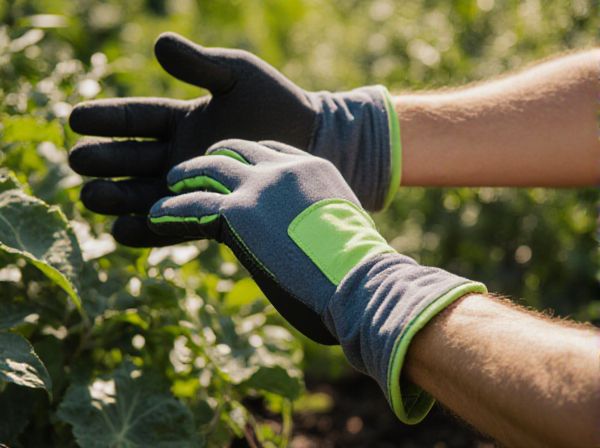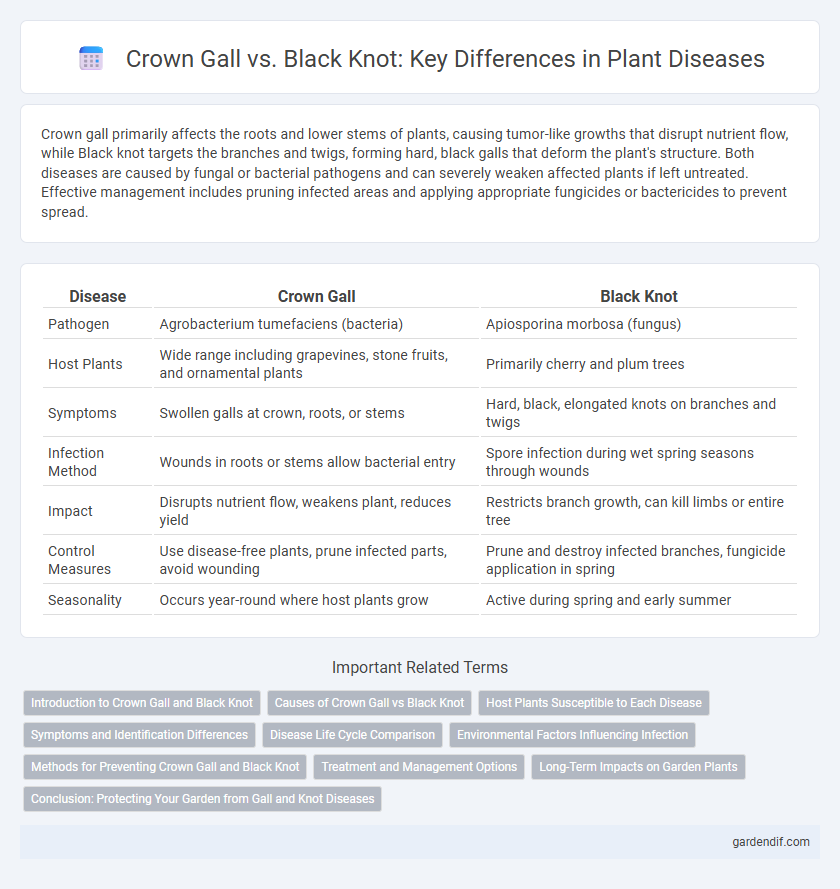
Crown gall vs Black knot Illustration
Crown gall primarily affects the roots and lower stems of plants, causing tumor-like growths that disrupt nutrient flow, while Black knot targets the branches and twigs, forming hard, black galls that deform the plant's structure. Both diseases are caused by fungal or bacterial pathogens and can severely weaken affected plants if left untreated. Effective management includes pruning infected areas and applying appropriate fungicides or bactericides to prevent spread.
Table of Comparison
| Disease | Crown Gall | Black Knot |
|---|---|---|
| Pathogen | Agrobacterium tumefaciens (bacteria) | Apiosporina morbosa (fungus) |
| Host Plants | Wide range including grapevines, stone fruits, and ornamental plants | Primarily cherry and plum trees |
| Symptoms | Swollen galls at crown, roots, or stems | Hard, black, elongated knots on branches and twigs |
| Infection Method | Wounds in roots or stems allow bacterial entry | Spore infection during wet spring seasons through wounds |
| Impact | Disrupts nutrient flow, weakens plant, reduces yield | Restricts branch growth, can kill limbs or entire tree |
| Control Measures | Use disease-free plants, prune infected parts, avoid wounding | Prune and destroy infected branches, fungicide application in spring |
| Seasonality | Occurs year-round where host plants grow | Active during spring and early summer |
Introduction to Crown Gall and Black Knot
Crown gall is a plant disease caused by the bacterium Agrobacterium tumefaciens, characterized by tumor-like growths or galls primarily on the roots and stems of various woody plants. Black knot is a fungal disease caused by Apiosporina morbosa, which manifests as rough, black, elongated swellings or knots on branches of stone fruit trees such as cherries and plums. Both diseases significantly impact plant health and productivity by disrupting nutrient flow and weakening structural integrity.
Causes of Crown Gall vs Black Knot
Crown gall is caused by the bacterial pathogen Agrobacterium tumefaciens, which infects plants through wounds, leading to tumor-like growths at the crown or roots. Black knot results from the fungal pathogen Apiosporina morbosa, infecting primarily cherry and plum trees and producing dark, knotty swellings on branches. Both diseases significantly impact plant health by disrupting nutrient flow and structural integrity.
Host Plants Susceptible to Each Disease
Crown gall primarily affects a wide range of dicotyledonous plants, including fruit trees such as apples, cherries, and plums, as well as ornamental shrubs like roses and grapevines. Black knot mainly targets members of the Prunus genus, particularly black cherry, plums, and apricots, causing unsightly proliferations on branches. Understanding the host specificity of crown gall and black knot aids in early detection and effective disease management in susceptible plants.
Symptoms and Identification Differences
Crown gall disease causes tumor-like galls primarily at the crown or roots of plants, often leading to swollen, woody growths that disrupt nutrient flow. Black knot, by contrast, produces hard, black, elongated swellings or knots on the branches and twigs, which can girdle and kill affected limbs. Identification of crown gall relies on the presence of irregular, rough galls near the soil line, whereas black knot is distinguished by smooth, shiny black knots higher on woody parts.
Disease Life Cycle Comparison
Crown gall and black knot diseases both involve fungal and bacterial pathogens with distinct life cycles impacting woody plants. Crown gall, caused by Agrobacterium tumefaciens, initiates infection through wounds and transfers DNA into the host plant cells, leading to tumor-like galls that persist and expand over years. Black knot, caused by the fungus Apiosporina morbosa, produces overwintering stromata on infected branches, releasing ascospores in spring that infect new shoots, completing its annual disease cycle with visible black swellings.
Environmental Factors Influencing Infection
Crown gall and Black knot diseases are influenced by specific environmental conditions that promote bacterial and fungal growth respectively. Crown gall infection thrives in warm, moist soils with wounds or injuries on the plant, facilitating Agrobacterium tumefaciens entry, while Black knot severity increases in humid climates with prolonged wetness favoring the spread of the fungus Apiosporina morbosa. Managing irrigation and pruning during dry periods reduces the risk of these diseases by limiting favorable conditions for pathogen development.
Methods for Preventing Crown Gall and Black Knot
Preventing crown gall involves avoiding wounding plants during propagation and using disease-free planting material to reduce Agrobacterium tumefaciens infection. Black knot prevention relies on pruning infected branches during dormancy and applying fungicides such as sulfur or chlorothalonil to protect susceptible Prunus species. Maintaining proper orchard sanitation and selecting resistant cultivars are critical strategies for managing both diseases effectively.
Treatment and Management Options
Crown gall treatment involves removing infected plant tissue and applying biocontrol agents like Agrobacterium radiobacter strain K84 to suppress tumor formation. Black knot management includes pruning infected branches during dormancy, ensuring proper sanitation by destroying infected debris, and applying fungicides such as chlorothalonil or myclobutanil to prevent spore germination. Both diseases benefit from maintaining plant vigor through adequate watering, fertilization, and selecting resistant cultivars to reduce susceptibility.
Long-Term Impacts on Garden Plants
Crown gall disease causes tumor-like growths on plant roots and stems, leading to nutrient and water transport disruption, which weakens garden plants over time and reduces overall vitality. Black knot primarily affects cherry and plum trees by forming hard, black swellings on branches, which can girdle and kill affected shoots, decreasing fruit production and compromising the tree's structural integrity. Both diseases result in long-term stress that diminishes plant health, making management critical for sustaining garden productivity and preventing widespread damage.
Conclusion: Protecting Your Garden from Gall and Knot Diseases
Effective management of crown gall and black knot diseases requires early identification and removal of infected plant parts to prevent spread. Implementing proper sanitation practices and selecting resistant plant varieties significantly reduces disease incidence. Consistent monitoring and timely application of appropriate treatments ensure a healthy, thriving garden free from gall and knot infections.
Crown gall vs Black knot Infographic

 gardendif.com
gardendif.com